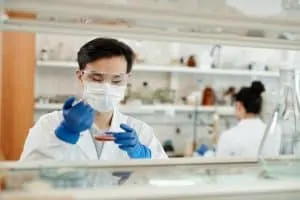Did you know that there are more than 25,000 chemical products that can cause a chemical injury to the skin?
One of the most corrosive chemical products that serve as a large danger to many people is sodium hydroxide. The United States Occupational Safety and Health Administration considers sodium hydroxide to be a corrosive agent. It causes irreversible skin injury after coming into contact with the skin after four hours.
Are you interested in learning about the hazards that sodium hydroxide poses to your employees? This quick guide will give you better insight into how dangerous sodium hydroxide actually is. Keep reading to learn more.
What Are the Health Effects of Sodium Hydroxide?
The main routes of exposure to sodium hydroxide include eye contact and skin contact. Sodium Hydroxide poses the biggest threat to the skin and the eyes because of its corrosive properties.
Skin and Eye Contact
When sodium hydroxide comes into contact with the skin or the eyes, it can cause severe burns, redness, and blistering. If sodium hydroxide comes into contact with the skin, acute and long-term exposure can result in death. One of the biggest dangers of sodium hydroxide is that the pain from a sodium hydroxide burn may be delayed up to a few hours.
Inhalation
The only way that you can inhale this Hazard is if the sodium hydroxide becomes airborne be dust. If inhaled, sodium hydroxide can cause severe irritation to both the throat and the nose.
Ingestion
If ingested, sodium hydroxide can burn the stomach, tongue, lips, and throat. Some of the symptoms that an individual can experience when ingesting sodium hydroxide include stomach cramps, nausea, vomiting, and diarrhea. Left untreated, the ingestion of sodium hydroxide can cause death.
What Steps Should Be Taken for First Aid Measures After Sodium Hydroxide Contact?
If one of your employees has been exposed to sodium hydroxide, taking first aid measures can reduce the immediate level of danger that your employee is in. In addition, after someone comes into contact with sodium hydroxide, taking first aid measures could even save their life.
Skin Contact
To avoid direct contact with sodium hydroxide, it’s important to wear chemical protective clothing.
When an individual’s skin comes into contact with sodium hydroxide, it’s important to quickly take off any contaminated clothing, shoes, and other accessories. Brush away the excess chemical and begin to flush the affected area with lukewarm water for sixty minutes.
Do not stop flushing during this sixty-minute time frame. If possible, continue to flush the affected area while being transported to a medical facility.
Eye Contact
To reduce the chances of eye injury caused by sodium hydroxide, wear protective eye gear when handling sodium hydroxide. If eyes come into contact, flush eyes with lukewarm water for sixty minutes while holding the eyelid back.
If an employee is wearing contact lenses, immediately remove the lenses from the eyes. Continue flushing with water. Immediately contact emergency medical help.
Ingestion
Have the affected individual rinse their mouth out with water. Immediately contact emergency medical help.
Inhalation
Move the affected employee to an area that has fresh air, such as outside.
Preventing Sodium Hydroxide Injuries in Your Workplace
Sodium Hydroxide is a hazardous chemical and can seriously harm your employees. If you’re looking to learn how to increase the safety measures in your workplace for handling Sodium Hydroxide, you should receive updated safety training.
Online-SDS management can help your employees remain safe by giving them barrier-free access to safety data sheets for dangerous chemicals such as Sodium Hydroxide. Click here to schedule a demo today!


